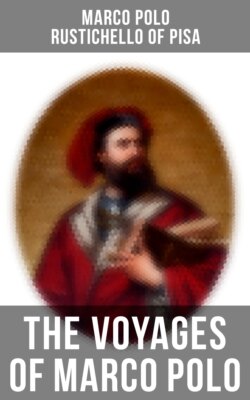Читать книгу The Voyages of Marco Polo - Марко Поло - Страница 41
На сайте Литреса книга снята с продажи.
ОглавлениеCHAPTER VII.
Table of Contents
HOW THE GREAT KAAN SENT THE TWO BROTHERS AS HIS ENVOYS TO THE POPE.
When that Prince, whose name was CUBLAY KAAN, Lord of the Tartars all over the earth, and of all the kingdoms and provinces and territories of that vast quarter of the world, had heard all that the Brothers had to tell him about the ways of the Latins, he was greatly pleased, and he took it into his head that he would send them on an Embassy to the Pope. So he urgently desired them to undertake this mission along with one of his Barons; and they replied that they would gladly execute all his commands as those of their Sovereign Lord. Then the Prince sent to summon to his presence one of his Barons whose name was COGATAL, and desired him to get ready, for it was proposed to send him to the Pope along with the Two Brothers. The Baron replied that he would execute the Lord's commands to the best of his ability.
After this the Prince caused letters from himself to the Pope to be indited in the Tartar tongue,[NOTE 1] and committed them to the Two Brothers and to that Baron of his own, and charged them with what he wished them to say to the Pope. Now the contents of the letter were to this purport: He begged that the Pope would send as many as an hundred persons of our Christian faith; intelligent men, acquainted with the Seven Arts,[NOTE 2] well qualified to enter into controversy, and able clearly to prove by force of argument to idolaters and other kinds of folk, that the Law of Christ was best, and that all other religions were false and naught; and that if they would prove this, he and all under him would become Christians and the Church's liegemen. Finally he charged his Envoys to bring back to him some Oil of the Lamp which burns on the Sepulchre of our Lord at Jerusalem.[NOTE 3]
NOTE 1.— + The appearance of the Great Kaan's letter may be illustrated by two letters on so-called Corean paper preserved in the French archives; one from Arghún Khan of Persia (1289), brought by Buscarel, and the other from his son Oljaitu (May, 1305), to Philip the Fair. These are both in the Mongol language, and according to Abel Rémusat and other authorities, in the Uighúr character, the parent of the present Mongol writing. Facsimiles of the letters are given in Rémusat's paper on intercourse with Mongol Princes, in Mém. de l' Acad. des Inscript. vols. vii. and viii., reproductions in J. B. Chabot's Hist. de Mar Jabalaha III., Paris, 1895, and preferably in Prince Roland Bonaparte's beautiful Documents Mongols, Pl. XIV., and we give samples of the two in vol. ii.[1]
NOTE 2.—"The Seven Arts," from a date reaching back nearly to classical times, and down through the Middle Ages, expressed the whole circle of a liberal education, and it is to these Seven Arts that the degrees in arts were understood to apply. They were divided into the Trivium of Rhetoric, Logic, and Grammar, and the Quadrivium of Arithmetic, Astronomy, Music, and Geometry. The 38th epistle of Seneca was in many MSS. (according to Lipsius) entitled "L. Annaei Senecae Liber de Septem Artibus liberalibus." I do not find, however, that Seneca there mentions categorically more than five, viz., Grammar, Geometry, Music, Astronomy, and Arithmetic. In the 5th century we find the Seven Arts to form the successive subjects of the last seven books of the work of Martianus Capella, much used in the schools during the early Middle Ages. The Seven Arts will be found enumerated in the verses of Tzetzes (Chil. XI. 525), and allusions to them in the mediaeval romances are endless. Thus, in one of the "Gestes d'Alexandre," a chapter is headed "Comment Aristotle aprent à Alixandre les Sept Arts." In the tale of the Seven Wise Masters, Diocletian selects that number of tutors for his son, each to instruct him in one of the Seven Arts. In the romance of Erec and Eneide we have a dress on which the fairies had portrayed the Seven Arts (Franc. Michel, Recherches, etc. II. 82); in the Roman de Mahommet the young impostor is master of all the seven. There is one mediaeval poem called the Marriage of the Seven Arts, and another called the Battle of the Seven Arts. (See also Dante, Convito, Trat. II. c. 14; Not. et Ex. V., 491 seqq.)
NOTE 3.—The Chinghizide Princes were eminently liberal—or indifferent—in religion; and even after they became Mahomedan, which, however, the Eastern branch never did, they were rarely and only by brief fits persecutors. Hence there was scarcely one of the non-Mahomedan Khans of whose conversion to Christianity there were not stories spread. The first rumours of Chinghiz in the West were as of a Christian conqueror; tales may be found of the Christianity of Chagatai, Hulaku, Abaka, Arghun, Baidu, Ghazan, Sartak, Kuyuk, Mangu, Kublai, and one or two of the latter's successors in China, all probably false, with one or two doubtful exceptions.
[1] See plates with ch. xvii. of Bk. IV. See also the Uighúr character in the second Païza, Bk. II. ch. vii.
[Illustration: The Great Kaan delivering a Golden Tablet to the Brothers. From a miniature of the 14th century.]
